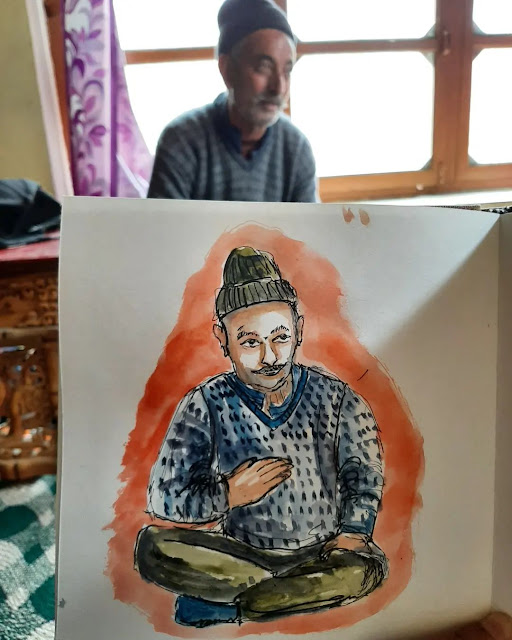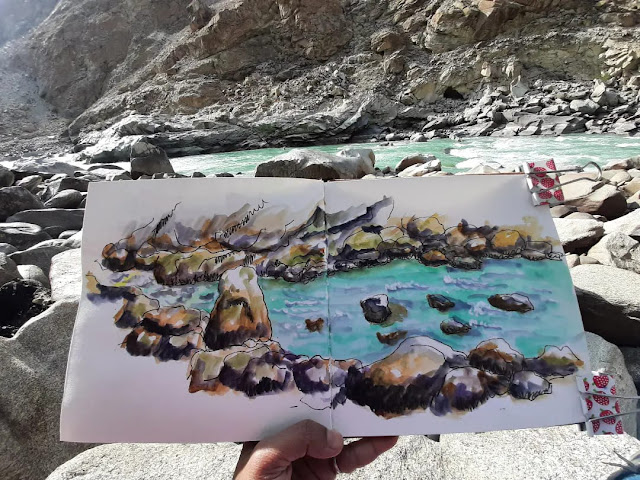 |
| Brokpa girls |
I spent five enriching days in Garkon, home to the Brokpa/Aryan/Dardic tribe, during the Apricot Blossom Festival in April 2022. My earlier plan was to spend two days in Garkon, but thanks to the bad experience in the Achinathang homestay (read my previous blog), I shortened my stay at Achinathang and spent two more days at Garkon. I took a bus from Achinathang to Garkon and reached the Payupa Guest House, run by Diskit and her husband Tashi Lundup. It is a multi-storied house with several rooms. Since I was traveling solo, they gave me a room on the ground floor with a shared bathroom and toilet.
This was the first sketch I did of the view outside.
 |
| Warming up for the Garkon sketch series |
I met a very interesting person in Garkon. He is the folk singer of the village, Sonam Wangyal, and was a storehouse of information about Brokpa culture and history. One thing he said was interesting. It was one of his relatives who had gone to graze his cattle on the border who discovered the infiltration of Pakistani terrorists on the border and informed the Indian Army, which eventually led to the Kargil war in 1999.
 |
Sonam Wangyal, the folk singer of Garkon
While walking around the village, I saw this old Brokpa house with Ibex horns on the door. After I had sketched it, the owner came along and offered me some dried apricots from her tree.
|
 |
A house with a lot of character in Garkon
I think it is now time to tell you about the Brokpa tribe. When Alexander, the Macedonian King invaded India in 326 BC, there were three soldier brothers who stayed back. Their names were Galo, Melo and Dhulo. They stayed back originally in the Gilgit Baltistan area and then wished to move to greener areas. One of the brothers shot an arrow and it fell in Dah (Dah means arrow), So Dah became the first settlement of the Brokpas and then eventually the descendants of the three brothers, settled in the villages of Hanu, Garkon, Darchik and 2-3 other villages, one of which is in Pakistan now. The Brokpas were animists and worshipped Nature and later embraced Buddhism. They do keep their animist traditions alive too with festivals and celebrations. Polyandry was common until a few generations ago. They speak a language called Dard or Shina and their language has no script. They speak Ladakhi fluently but the Ladakhis cannot understand their language. They marry only within their community although that is fast changing with the younger generation going to cities for work and studies. Both men and women wear headgear with flowers on it. |
 |
| Two young Brokpa girls |
 |
| Two young Brokpa girls |
I was lucky that on the day I was there, 14th April 2022, the Apricot Blossom Festival, locally called Chuli Menduq was being organized by the Department of Tourism. All the Brokpas from Garkon and the neighboring villages came in all their traditional attire and finery. The Brokpas looked like walking floral bouquets. So amazing. I noticed that the Brokpa attire is a celebration of all things sourced from earth. There is silver, pearls, coral, flowers, turquoise, sea shells, goat leather, coins, seeds, wool, etc. It was a bonus for me. It was a riot of colour and a feast for the eyes. There was dance and music too and I sketched in a frenzy to capture as much as I could.
The bright orange flower, Monthu-tho, is very important for the Brokpas. They value it even more than gold or silver. Whenever there is a dispute between people, this flower is offered as truce and to symbolize peace. During all the happy occasions like weddings or birth of a child, all the community members wear this flower as part of their headgear. This flower grows in a shrub in the fields in September. This is the headgear worn by Brokpa women.
 |
| The floral headgear for Brokpa women called Molan Kho |
 |
| Monthu Tho- the most important flower for the Brokpas |
I also sketched the Brokpa footwear and pants worn by women.
The shoes are called 'Aala Peela'. Peela means shoes in their language. The bottom part is made of goat leather and the upper part of wool. So colorful! I am considering joining the Brokpa tribe for their sheer love for bright colours.
The pant is worn underneath the kaftan or Kurta and is made of wool with rich embroidery in bright colors. It was quite heavy to hold.
 |
| Brokpa women's pants |
 |
| Brokpa shoes called Aala Peela |
I wanted to do another portrait of a Brokpa woman and the mother of my homestay owner sweetly agreed to pose for me. The Brokpa women wear their hair in 14 plaits. 4 on each side and 6 behind. This lady told me when she was young, they had to comb their hair everyday and plait it. They never cut their hair. But now things have changed. She said earlier, rajma (kidney beans) and corn and other seeds were used as part of their attire. The silver used to come from Skardu, now in Pakistan. The traders would exchange salt in exchange for silver.
Brokpa girls from the back. They wear a cape made of goat skin and until two generations ago, girls weren't allowed to go outside or be seen by men without the goat skin. |
| The cape of the Brokpa girls. |
 |
| The traditional attire of the Brokpas is elaborate and heavy! |
I got the opportunity to watch and sketch Brokpa musicians on percussion and wind instruments. The Brokpa songs are all about Nature, about Apricot blossoms, the river, the mountains. They share a close connection to nature like most people in the villages.
The wind instrument is called Surna, the tabla like instrument is called Daman, the sticks are called Danshing and the single percussion instrument is Bhoonsh.
You may like to read my post on the Lepcha tribe in Sikkim.
I think the Brokpa men may be the only men in the world to wear floral headgear with such confidence and elegance.
 |
| Brokpa men with floral headgear |
This is a 500 yrs old Ladakhi house belonging to the family of Tashi Lundup, @payupaguesthouse which has now been converted into a museum. This was restored 150 yrs ago in its current state. It is a 4 storied structure. The ground floor called the 'Bhu' was used for keeping goats and sheep. The 1st floor is called Kattsa, used during winters where the entire family gathered. Leading to the Kattsa is another large room, where the handprints of Guru Padma Sambhava are kept on a Sabdak, an ancient symbolic rock, which represents the local deity. The food after being prepared is first offered to the deity and then partaken. There are small cells for storing butter and hold household items. The 2nd floor is called Sbyarkhang, used in summer. The 3rd floor is a prayer room called Chokthang. 4th floor is the terrace.
 |
| Brokpa museum in Garkon |
Some of the items in the museum as such these pots are made of stone. They are over 200 years old and were made in what is now Pakistan.
 |
| Collection of museum artifacts |
At Garkon, I felt fortunate to sit by the Sindhu/Indus river, from which our country Bharat gets its anglicized name India, and sketch this beautiful scene, with the sound of the gurgling river water and the musical notes of the Whistling Thrush. The sun cast a molten golden glow on the waters on the horizon. So beautiful! I wanted to go and touch the water and fill up my water brushes too, but I already had a swollen ankle and thought that navigating more of these boulders would cause more strain. There will be another time I am sure.  |
| Indus river in Garkon |
As I was wandering around the village, a young man Phunchok invited me to see his newly renovated guest house called Betepa Guesthouse. He offered me tea and I sat on the terrace and sketched this panoramic view.
 |
| Phunchok of Betepa Guest house in Garkon |
Below is the Payupa Guesthouse.
As I had mentioned earlier, the Brokpas have kept their animist traditions alive alongside the Buddhist practices. This is the sacred walnut tree of the village called Changri Aatho, where their guardian spirit is believed to be residing. Every year, the Brokpa villages take turns celebrating the Bon festival called Bonona. So Garkon gets its chance every three years. The tree and stone are worshipped and offered holy fumes called Phok (juniper leaves). The first harvest of the season is also offered to the tree and villagers come in traditional attire and sing and dance in celebration.
During the Apricot blossom festival, the men and women performed a folk dance. It was a slow-moving dance but very graceful and the dancers sang in chorus. One of the women offered me a headgear. It was very heavy on my head. The songs they sang were about Nature, love, river and mountains.
A coffee table at Paupa guesthouse with Tibetan Buddhist motifs. This kind of decor is ubiquitous in the regions practicing Tibetan Buddhism such as Sikkim, Arunachal Pradesh, Ladakh, and parts of Himachal Pradesh.
My hostess at Payupa Guest House, Diskit, made this syrupy side dish with dried apricots which are just boiled in plain water. The result is a syrupy jam-like dish that pairs well with rice-dal and rotis.
Seeing me sketch at the Chuli Menduq, a Tourism minister of Ladakh, Aga Syed Taha, asked me to draw a portrait of him. I said I did not have loose papers and that I wouldn't tear a page from my sketchbook. He managed to get some A4 printer paper and asked me to draw on that. |
| Assistant Director of Tourism, Aga Syed Taha |
All in all, my Garkon visit was extremely fulfilling as I got a deeper insight into the culture of the Brokpas. My next stop after Garkon was Temisgam/Tingmosgang which was equally beautiful in its own way. Read about it here.
If you have enjoyed reading this post, you may subscribe to new post updates via email. Enter your email id in the 'Follow by email' on the right-hand side panel.


















































